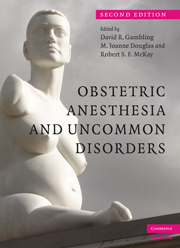Book contents
- Frontmatter
- Contents
- List of plates
- List of contributors
- Preface
- Section 1 Cardiovascular and respiratory disorders
- Section 2 Musculoskeletal disorders
- Section 3 Nervous system disorders
- 9 Disorders of the central nervous system in pregnancy
- 10 Spinal cord disorders
- 11 Peripheral neuropathy
- 12 Chronic pain in pregnancy
- Section 4 Metabolic disorders
- Section 5 Other disorders
- Index
- Plate Section
- References
10 - Spinal cord disorders
from Section 3 - Nervous system disorders
Published online by Cambridge University Press: 19 October 2009
- Frontmatter
- Contents
- List of plates
- List of contributors
- Preface
- Section 1 Cardiovascular and respiratory disorders
- Section 2 Musculoskeletal disorders
- Section 3 Nervous system disorders
- 9 Disorders of the central nervous system in pregnancy
- 10 Spinal cord disorders
- 11 Peripheral neuropathy
- 12 Chronic pain in pregnancy
- Section 4 Metabolic disorders
- Section 5 Other disorders
- Index
- Plate Section
- References
Summary
Introduction
Patients with spinal cord injuries and spina bifida are not commonly encountered in the obstetrical population, but their numbers will increase in the future as a result of improved surgical techniques and rehabilitation therapy. Also, women with degenerative spinal cord diseases such as spinal muscular atrophy, and amyotrophic lateral sclerosis are surviving to child-bearing age and choosing to become pregnant despite the risks. Unusual diseases of the spinal cord such as tethered cord, syringomyelia and postpolio syndrome are also known to occur in pregnant women.
Spinal cord injury
The incidence of spinal cord injury (SCI) is 25–30 per million of population in North America, or 10,000 new cases per year in the USA. Most victims are young, and in Canada 20% of them are female. Advances in both acute and rehabilitation care have led to improved outcomes resulting in higher levels of independent function after SCI. Rehabilitation emphasizes integration back into society and cord-injured patients are encouraged to work, establish relationships, and have families.
Pregnancy in SCI patients is no longer rare; a 1999 survey looked at 472 women with SCI, all at least one year post injury. Fourteen percent became pregnant after their injury, and in 60% it was their first pregnancy. The average time to pregnancy following SCI is 4 to 13 years, but the average age at pregnancy and time interval since injury have decreased in the last few years. The first successful pregnancy in a quadriplegic was reported in 1953.
- Type
- Chapter
- Information
- Obstetric Anesthesia and Uncommon Disorders , pp. 191 - 214Publisher: Cambridge University PressPrint publication year: 2008



